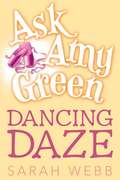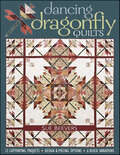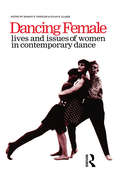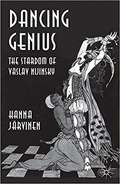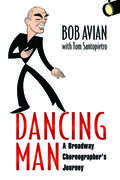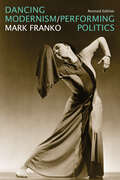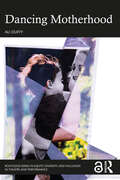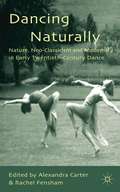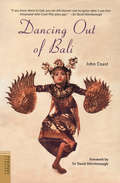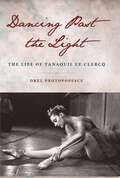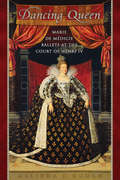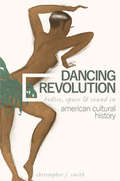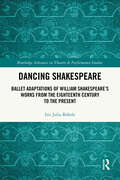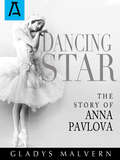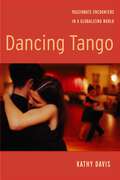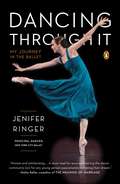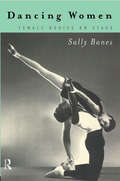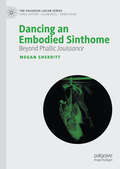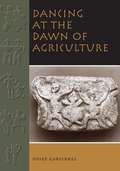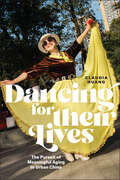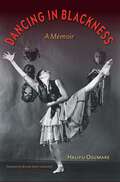- Table View
- List View
Dancing Cultures
by Jonathan Skinner Helene Neveu KringelbachDance is more than an aesthetic of life - dance embodies life. This is evident from the social history of jive, the marketing of trans-national ballet, ritual healing dances in Italy or folk dances performed for tourists in Mexico, Panama and Canada. Dance often captures those essential dimensions of social life that cannot be easily put into words. What are the flows and movements of dance carried by migrants and tourists? How is dance used to shape nationalist ideology? What are the connections between dance and ethnicity, gender, health, globalization and nationalism, capitalism and post-colonialism? Through innovative and wide-ranging case studies, the contributors explore the central role dance plays in culture as leisure commodity, cultural heritage, cultural aesthetic or cathartic social movement.
Dancing Days (Ask Amy Green #5)
by Sarah WebbBallet intrigue, a best friend predicament, and a bullying problem to solve keep Amy plenty busy in a new adventure. Claire, the older sister of Amy Green’s very best friend, Mills, has a dancing dilemma. Claire has landed the lead in Budapest Ballet Company’s production of Romeo and Juliet. It’s the role of a lifetime (not to mention that her Romeo is the hot and talented Hungarian dancer P#65533;ter Bako), so why does she seem so depressed? And why won’t she talk to anyone about what’s bothering her? Amy Green and her aunt Clover, advice-givers extraordinaire, are coming to the rescue. It may take some serious snooping and a trip to Budapest, but Amy and Clover are determined to help the budding ballet star get back on her feet. Ages 8-13 There's plenty going on with Amy Green in the Bookshare collection. Look for Boy trouble, Summer Secrets, Bridesmaid Blitz, Love and Other Drama-Ramas and Wedding Belles
Dancing Dragonfly Quilts
by Sue BeeversDaring, dramatic, dazzling—make 12 stunning contemporary quilts from the traditional Dragonfly block Expand the design possibilities with 6 variations on the basic block Learn how to create different looks by playing with your fabric’s colors, textures, and values Assemble your Dragonflies with traditional piecing, templates, paper piecing, or modified paper piecing Everything you need to create dazzling new quilts from the traditional Dragonfly block is here in this comprehensive workbook. Try any of the 12 complete quilt projects, or use Sue’s design techniques to make your own original Dragonfly designs.
Dancing Female (Choreography and Dance Studies Series #Vol. 12)
by Sharon E. Friedler Susan B. GlazerFirst Published in 1997. Routledge is an imprint of Taylor & Francis, an informa company.
Dancing Genius: The Stardom of Vaslav Nijinsky
by Hanna JärvinenTracing the historical figure of Vaslav Nijinsky in contemporary documents and later reminiscences, Dancing Genius opens up questions about authorship in dance, about critical evaluation of performance practice, and the manner in which past events are turned into history.
Dancing Indigenous Worlds: Choreographies of Relation
by Jacqueline Shea MurphyThe vital role of dance in enacting the embodied experiences of Indigenous peoples In Dancing Indigenous Worlds, Jacqueline Shea Murphy brings contemporary Indigenous dance makers into the spotlight, putting critical dance studies and Indigenous studies in conversation with one another in fresh and exciting new ways. Exploring Indigenous dance from North America and Aotearoa (New Zealand), she shows how dance artists communicate Indigenous ways of being, as well as generate a political force, engaging Indigenous understandings and histories.Following specific dance works over time, Shea Murphy interweaves analysis, personal narrative, and written contributions from multiple dance artists, demonstrating dance&’s crucial work in asserting and enacting Indigenous worldviews and the embodied experiences of Indigenous peoples. As Shea Murphy asserts, these dance-making practices can not only disrupt the structures that European colonization feeds upon and strives to maintain, but they can also recalibrate contemporary dance. Based on more than twenty years of relationship building and research, Shea Murphy&’s work contributes to growing, and largely underreported, discourses on decolonizing dance studies, and the geopolitical, gendered, racial, and relational meanings that dance theorizes and negotiates. She also includes discussions about the ethics of writing about Indigenous knowledge and peoples as a non-Indigenous scholar, and models approaches for doing so within structures of ongoing reciprocal, respectful, responsible action.
Dancing Man: A Broadway Choreographer's Journey
by Bob AvianTony and Olivier Award–winning Bob Avian’s dazzling life story, Dancing Man: A Broadway Choreographer’s Journey, is a memoir in three acts. Act I reveals the origins of one of Broadway’s legendary choreographers who appeared onstage with stars like Barbra Streisand and Mary Martin all before he was thirty. Act II includes teaching Katharine Hepburn how to sing and dance in Coco and working with Stephen Sondheim and Michael Bennett while helping to choreograph the original productions of Company and Follies. During this time, Avian won a Tony Award as the cochoreographer of A Chorus Line and produced the spectacular Tony Award–winning Dreamgirls. For a triumphant third act, Avian choreographed Julie Andrews’s return to the New York stage, devised all of the musical staging for Miss Saigon and Sunset Boulevard, and directed A Chorus Line on Broadway. He worked with the biggest names on Broadway, including Andrew Lloyd Webber, Carol Burnett, Jennifer Holliday, Patti LuPone, Elaine Stritch, and Glenn Close. Candid, witty, sometimes shocking, and always entertaining, here at last is the ultimate up-close and personal insider’s view from a front row seat at the creation of the biggest, brightest, and best Broadway musicals of the past fifty years.
Dancing Modernism / Performing Politics
by Mark FrankoIn the much-anticipated update to a classic in dance studies, Mark Franko analyzes the political aspects of North American modern dance in the 20th century.A revisionary account of the evolution of modern dance, this revised edition of Dancing Modernism / Performing Politics features a foreword by Juan Ignacio Vallejos on Franko's career, a new preface, a new chapter on Yvonne Rainer, and an appendix of left-wing dance theory articles from the 1930s. Questioning assumptions that dancing reflects culture, Franko employs a unique interdisciplinary approach to dance analysis that draws from cultural theory, feminist studies, and sexual, class, and modernist politics. Franko also highlights the stories of such dancers as Isadora Duncan, Martha Graham, and even revolutionaries like Douglas Dunn in order to upend and contradict ideas on autonomy and traditionally accepted modernist dance history.Revealing the captivating development of modern dance, this revised edition of Dancing Modernism / Performing Politics will fascinate anyone interested in the intersection of performance studies, history, and politics.
Dancing Motherhood (Routledge Series in Equity, Diversity, and Inclusion in Theatre and Performance)
by Ali DuffyDancing Motherhood explores how unique factors about the dance profession impact pregnant women and mothers working in it. Ali Duffy introduces the book by laying a foundation of social and cultural histories and systemic structures and power that shape the issues mothers in dance negotiate today. This book then reveals perspectives from mothers in dance working in areas such as performance, choreography, dance education, administration, and advocacy though survey and interview data. Based on participant responses, recommendations for changes in policy, hiring, evaluation, workplace environment, and other professional and personal practices to better support working mothers in dance are highlighted. Finally, essays from eight working mothers in dance offer intimate, personal stories and guidance geared to mothers, future mothers, policymakers, and colleagues and supervisors of mothers in the dance field. By describing lived experiences and offering suggestions for improved working conditions and advocacy, this book initiates expanded discussion about women in dance and promotes change to positively impact dancing mothers, their employers, and the dance field.
Dancing Naturally
by Alexandra Carter Rachel FenshamA renewed interest in nature, the ancient Greeks, and the freedom of the body was to transform dance and physical culture in the early twentieth century. The book discusses the creative individuals and developments in science and other art forms that shaped the evolution of modern dance in its international context.
Dancing Out of Bali
by Richard Attenborough John Coast"It is Bali felt, understood, loved, communicated...Coast has a kind of word magic." --New York Herald TribuneThis book tells of a young Englishman, fresh out of a Japanese prison camp, and his Javanese wife, and how they leave Indonesia for the footlights of Broadway. This is a story of life, music, and dancing in Bali, with all the charm of the Balinese people. Dancing out of Bali is a truly remarkable personal adventure story for all readers, especially dance lovers.
Dancing Out of Bali
by Richard Attenborough John Coast"It is Bali felt, understood, loved, communicated...Coast has a kind of word magic." --New York Herald TribuneThis book tells of a young Englishman, fresh out of a Japanese prison camp, and his Javanese wife, and how they leave Indonesia for the footlights of Broadway. This is a story of life, music, and dancing in Bali, with all the charm of the Balinese people. Dancing out of Bali is a truly remarkable personal adventure story for all readers, especially dance lovers.
Dancing Out of Bali
by Richard Attenborough John Coast"If you know where to look, you can still discover and recognize what it was that intoxicating John Coast fifty years ago." -Sir David AttenboroughThis book is one of the great classics about Bali, now with dozens of illustrations and photographs.Dancing out of Bali is a fascinating personal account of a young Englishman who settled in a small house in Bali in the midst of the political turmoil that griped post-war Indonesia. There, he immersed himself in Balinese culture and made ambitious plans to bring a troupe of Balinese dancers and musicians to Europe and America. The book relates John Coast's daring and remarkable adventure that took him from revolution in Indonesia to the footlights of London and Broadway. Within a few weeks, the troupe had captured the hearts of audiences. Here are photographs of Bali and stories of the performer's magic island and of the enchanting dancers, including the beautiful 12-year-old Ni Gusti Raka. She became a star overnight and delighted audiences everywhere during the troupe's triumphant tour.It is also a story of Balinese culture and life in Bali-following the devastating Japanese occupation-of music and dancing in Bali, of many of the island's great performing dancers and musicians,
Dancing Past the Light: The Life of Tanaquil Le Clercq
by Orel ProtopopescuA world-famous ballerina’s dramatic life Dancing Past the Light cinematically illuminates the glamorous and moving life story of Tanaquil “Tanny” Le Clercq (1929‒2000), one of the most celebrated ballerinas of the twentieth century, describing her brilliant stage career, her struggle with polio, and her important work as a dance teacher, coach, photographer, and writer. Born in Paris, Le Clercq became a principal dancer with the New York City Ballet at age 19 and a role model for aspiring dancers everywhere. Orel Protopopescu recounts Le Clercq’s intense marriage to the company’s renowned choreographer George Balanchine, for whom Le Clercq was a muse, the prototype of the exquisite, long-limbed “Balanchine ballerina.” Enhanced with a wealth of previously unpublished photos, personal letters, and sketches by Balanchine, this book offers an intimate portrait of Le Clercq’s dancing life and her relationship to the man who was both her mentor and husband. It delves into her friendships with other dancers as well, including a longtime rival for her affections, choreographer Jerome Robbins. Le Clercq contracted polio while on tour in Europe at age 27 and would never dance again. This book offers a rare account of how Le Clercq grappled with a fate considered unimaginable for a ballerina and began to share her love of dance as a writer and dance teacher. It also highlights Le Clercq’s role in the struggles for racial equality and disability rights. Her art was her vehicle: she and Arthur Mitchell made history as the couple in New York City Ballet’s first interracial pas de deux at City Center in 1955 and later she taught from a wheelchair at his Dance Theatre of Harlem. With insights from interviews with her friends, students, and colleagues, Dancing Past the Light depicts the joys and the dark moments of Le Clercq’s dramatic life, celebrating her mighty legacy.
Dancing Queen: Marie de Médicis' Ballets at the Court of Henri IV
by Melinda GoughUnder glittering lights in the Louvre palace, the French court ballets danced by Queen Marie de Médicis prior to Henri IV’s assassination in 1610 attracted thousands of spectators ranging from pickpockets to ambassadors from across Europe. Drawing on newly discovered primary sources as well as theories and methodologies derived from literary studies, political history, musicology, dance studies, and women’s and gender studies, Dancing Queen traces how Marie’s ballets authorized her incipient political authority through innovative verbal and visual imagery, avant-garde musical developments, and ceremonial arrangements of objects and bodies in space. Making use of women’s "semi-official" status as political agents, Marie’s ballets also manipulated the subtle social and cultural codes of international courtly society in order to more deftly navigate rivalries and alliances both at home and abroad. At times the queen’s productions could challenge Henri IV’s immediate interests, contesting the influence enjoyed by his mistresses or giving space to implied critiques of official foreign policy, for example. Such defenses of Marie’s own position, though, took shape as part of a larger governmental program designed to promote the French consort queen’s political authority not in its own right but as a means of maintaining power for the new Bourbon monarchy in the event of Henri IV’s untimely death.
Dancing Revolution: Bodies, Space, and Sound in American Cultural History (Music in American Life)
by Christopher J. SmithThroughout American history, patterns of political intent and impact have linked the wide range of dance movements performed in public places. Groups diverse in their cultural or political identities, or in both, long ago seized on dancing in our streets, marches, open-air revival meetings, and theaters, as well as in dance halls and nightclubs, as a tool for contesting, constructing, or reinventing the social order. Dancing Revolution presents richly diverse cases studies to illuminate these patterns of movement and influence in movement and sound in the history of American public life. Christopher J. Smith spans centuries, geographies, and cultural identities as he delves into a wide range of historical moments. These include: the God-intoxicated public demonstrations of Shakers and Ghost Dancers in the First and Second Great Awakenings; creolized antebellum dance in cities from New Orleans to Bristol; the modernism and racial integration that imbued twentieth-century African American popular dance; and public movement's contributions to hip hop, anti-hegemonic protest, and other contemporary transgressive communities’ physical expressions of dissent and solidarity. Multidisciplinary and wide-ranging, Dancing Revolution examines how Americans turned the rhythms of history into the movement behind the movements.
Dancing Shakespeare: Ballet Adaptations of William Shakespeare’s Works from the Eighteenth Century to the Present (Routledge Advances in Theatre & Performance Studies)
by Iris Julia BührleDancing Shakespeare is the first history of ballets based on William Shakespeare’s works from the birth of the dramatic story ballet in the eighteenth century to the present. It focuses on two main questions: "How can Shakespeare be danced?" and "How can dance shed new light on Shakespeare?"The book explores how librettists and choreographers have transposed Shakespeare’s complex storylines, multifaceted protagonists, rhetoric and humour into non-verbal means of expression, often going beyond the texts in order to comment on them or use them as raw material for their own creative purposes.One aim of the monograph is to demonstrate that the study of wordless performances allows us to gain a deeper understanding of Shakespeare’s texts. It argues that ballets based on Shakespeare’s works direct the audience’s attention to the "bare bones" of the plays: their situations, their characters, and the evolution of both. Moreover, they reveal and develop the "choreographies" that are written into the texts and highlight the importance of movements and gestures as signifiers in Shakespeare’s plays.This book will be of interest to students and scholars of literature, dance, and music, as well as to an international readership of lovers of Shakespeare, ballet, and the arts.
Dancing Star: The Story of Anna Pavlova
by Gladys MalvernIn this biographical novel, Gladys Malvern shares the incredible story of Anna Pavlova, one of the most revered and celebrated ballerinas of all time. Malvern presents Pavlova's life in enchanting prose, allowing the reader to experience Pavlova's inspirational first exposure to a performance of Sleeping Beauty, the origination of her defining dance The Dying Swan, her illustrious rise to fame as a prima ballerina, and her extensive world tours. You don't have to be a fan of the ballet to enjoy this captivating tale, available for the first time in ebook.
Dancing Tango: Passionate Encounters in a Globalizing World
by Kathy DavisArgentinean tango is a global phenomenon. Since its origin among immigrants from the slums of Buenos Aires and Montevideo, it has crossed and re-crossed many borders.Yet, never before has tango been danced by so many people and in so many different places as today. Argentinean tango is more than a specific music and style of dancing. It is also a cultural imaginary which embodies intense passion, hyper-heterosexuality, and dangerous exoticism.In the wake of its latest revival, tango has become both a cultural symbol of Argentinean national identity and a transnational cultural space in which a modest, yet growing number of dancers from different parts of the globe meet on the dance floor.Through interviews and ethnographical research in Amsterdam and Buenos Aires, Kathy Davis shows why a dance from another era and another place appeals to men and women from different parts of the world and what happens to them as they become caught up in the tango salon culture. She shows how they negotiate the ambivalences, contradictions, and hierarchies of gender, sexuality, and global relations of power between North and South inwhich Argentinean tango is—and has always been—embroiled.Davis also explores her uneasiness about her own passion for a dance which—when seen through the lens of contemporary critical feminist and postcolonial theories—seems, at best, odd, and, at worst, disreputable and even a bit shameful. She uses the disjuncture between the incorrect pleasures and complicated politics of dancing tango as a resource for exploring the workings of passion as experience, as performance, and as cultural discourse. She concludes that dancing tango should be viewed less as a love/hate embrace with colonial overtones than a passionate encounter across many different borders between dancers who share a desire for difference and a taste of the ‘elsewhere.’ Dancing Tango is a vivid, intriguing account of an important global cultural phenomenon.
Dancing Through It
by Jenifer RingerA behind-the-curtains look at the rarefied world of classical ballet from a principal dancer at the New York City Ballet In her charming and self-effacing voice, Jenifer Ringer covers the highs and lows of what it's like to make it to the top in the exclusive, competitive ballet world. From the heart-pounding moments waiting in the wings before a performance to appearing on Oprah to discuss weight and body image among dancers, Dancing Through It is moving and revelatory. Raised in South Carolina, Ringer led a typical kid's life until she sat in on a friend's ballet class, an experience that would change her life forever. By the age of twelve she was enrolled at the elite Washington School of Ballet and soon moved to the School of American Ballet. At sixteen she was a professional dancer at the New York City Ballet in Manhattan, home of the legendary George Balanchine and Jerome Robbins. Ringer takes us inside the dancer's world, detailing a typical day, performance preparation, and the extraordinary pressures that these athletes face. Ringer shares exhilarating stories of starring in Balanchine productions, working with the famous Peter Martins, and of meeting her husband and falling in love at the New York City Ballet. Ringer also talks candidly of Alistair Macauley's stinging critique of her weight in his 2010 New York Times review of The Nutcracker that ignited a public dialogue about ballet and weight. She unflinchingly describes her personal struggles with eating disorders and body image, and shares how her faith helped her to heal and triumph over these challenges.
Dancing Women: Female Bodies Onstage
by Sally BanesDancing Women: Female Bodies Onstage is a spectacular and timely contribution to dance history, recasting canonical dance since the early nineteenth century in terms of a feminist perspective. Setting the creation of specific dances in socio-political and cultural contexts, Sally Banes shows that choreographers have created representations of women that are shaped by - and that in part shape - society's continuing debates about sexuality and female identity. Broad in its scope and compelling in its argument Dancing Women: * provides a series of re-readings of the canon, from Romantic and Russian Imperial ballet to contemporary ballet and modern dance * investigates the gaps between plot and performance that create sexual and gendered meanings * examines how women's agency is created in dance through aspects of choreographic structure and style * analyzes a range of women's images - including brides, mistresses, mothers, sisters, witches, wraiths, enchanted princesses, peasants, revolutionaries, cowgirls, scientists, and athletes - as well as the creation of various women's communities on the dance stage * suggests approaches to issues of gender in postmodern dance Using an interpretive strategy different from that of other feminist dance historians, who have stressed either victimization or celebration of women, Banes finds a much more complex range of cultural representations of gender identities.
Dancing an Embodied Sinthome: Beyond Phallic Jouissance (The Palgrave Lacan Series)
by Megan SherrittThis book provides the first in-depth analysis of Lacanian psychoanalytic theory and the art of dance and explores what each practice can offer the other. It takes as its starting point Jacques Lacan’s assertion that James Joyce’s literary works helped him create what Lacan terms a sinthome, thereby preventing psychosis. That is, Joyce’s use of written language helped him maintain a “normal” existence despite showing tendencies towards psychosis. Here it is proposed that writing was only the method through which Joyce worked but that the key element in his sinthome was play, specifically the play of the Lacanian real.The book moves on to consider how dance operates similarly to Joyce’s writing and details the components of Joyce’s sinthome, not as a product that keeps him sane, but as an interminable process for coping with the (Lacanian) real. The author contends that Joyce goes beyond words and meaning, using language’s metre, tone, rhythm, and cadence to play with the real, mirroring his experience of it and confining it to his works, creating order in the chaos of his mind. The art of dance is shown to be a process that likewise allows one to play with the real. However, it is emphasized that dance goes further: it also teaches someone how to play if one doesn't already know how. This book offers a compelling analysis that sheds new light on the fields of psychoanalysis and dance and looks to what this can tell us about—and the possibilities for—both practices, concluding that psychoanalysis and dance both offer processes that open possibilities that might otherwise seem impossible. This original analysis will be of particular interest to those working in the fields of psychoanalysis, aesthetics, psychoanalytic theory, critical theory, art therapy, and dance studies.
Dancing at the Dawn of Agriculture
by Yosef GarfinkelAs the nomadic hunters and gatherers of the ancient Near East turned to agriculture for their livelihood and settled into villages, religious ceremonies involving dancing became their primary means for bonding individuals into communities and households into villages. So important was dance that scenes of dancing are among the oldest and most persistent themes in Near Eastern prehistoric art, and these depictions of dance accompanied the spread of agriculture into surrounding regions of Europe and Africa. In this pathfinding book, Yosef Garfinkel analyzes depictions of dancing found on archaeological objects from the Near East, southeastern Europe, and Egypt to offer the first comprehensive look at the role of dance in these Neolithic (7000-4000 BC) societies. In the first part of the book, Garfinkel examines the structure of dance, its functional roles in the community (with comparisons to dance in modern pre-state societies), and its cognitive, or symbolic, aspects. This analysis leads him to assert that scenes of dancing depict real community rituals linked to the agricultural cycle and that dance was essential for maintaining these calendrical rituals and passing them on to succeeding generations. In the concluding section of the book, Garfinkel presents and discusses the extensive archaeological data—some 400 depictions of dance—on which his study is based.
Dancing for Their Lives: The Pursuit of Meaningful Aging in Urban China (Global Perspectives on Aging)
by Claudia HuangDancing for Their Lives explores the vibrant world of retired Chinese women known as "dancing grannies” who seek fulfillment and companionship amidst societal upheaval. These women, part of China’s “lost generation,” gather in parks and public squares to reclaim their lives through dance in the wake of Chinese economic and cultural transformations. The book challenges prevailing narratives of aging societies, portraying old age as a site of social innovation rather than decline. Based on ethnographic research conducted in Chengdu, China, Dancing for Their Lives reveals how retirees learn to navigate shifting social norms and values while actively creating new models for growing older. The book’s insights resonate beyond Chinese society, offering lessons on resilience and the pursuit of meaning in any aging population. Dancing for Their Lives underscores the human capacity to craft purposeful lives amid uncertainty, transcending geographical boundaries to illuminate the universal quest for fulfillment in later years.
Dancing in Blackness: A Memoir
by Halifu OsumareDancing in Blackness is a professional dancer's personal journey over four decades, across three continents and 23 countries, and through defining moments in the story of black dance in America. In this memoir, Halifu Osumare reflects on what blackness and dance have meant to her life and international career. Osumare's story begins in 1960s San Francisco amid the Black Arts Movement, black militancy, and hippie counterculture. It was there, she says, that she chose dance as her own revolutionary statement. Osumare describes her experiences as a young black dancer in Europe teaching "jazz ballet" and establishing her own dance company in Copenhagen. Moving to New York City, she danced with the Rod Rodgers Dance Company and took part in integrating the programs at the Lincoln Center. After doing dance fieldwork in Ghana, Osumare returned to California and helped develop Oakland’s black dance scene. Osumare introduces readers to some of the major artistic movers and shakers she collaborated with throughout her career, including Katherine Dunham, Pearl Primus, Jean-Leon Destine, Alvin Ailey, and Donald McKayle. Now a black studies scholar, Osumare uses her extraordinary experiences to reveal the overlooked ways that dance has been a vital tool in the black struggle for recognition, justice, and self-empowerment. Her memoir is the inspiring story of an accomplished dance artist who has boldly developed and proclaimed her identity as a black woman.

